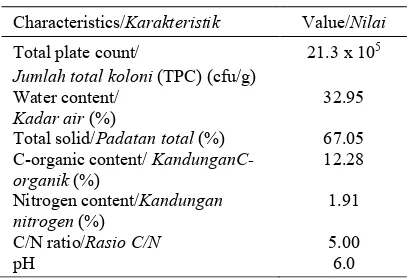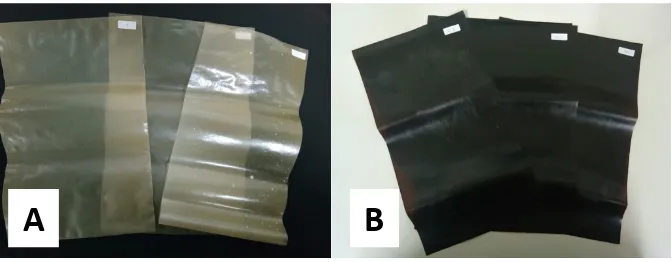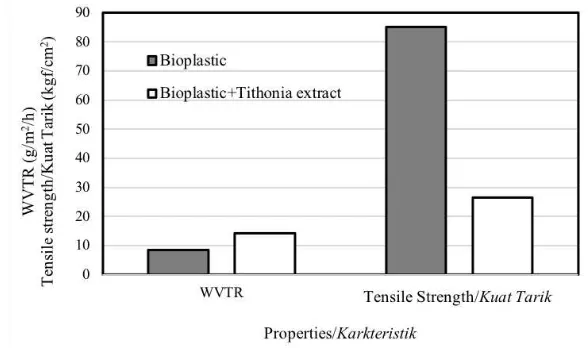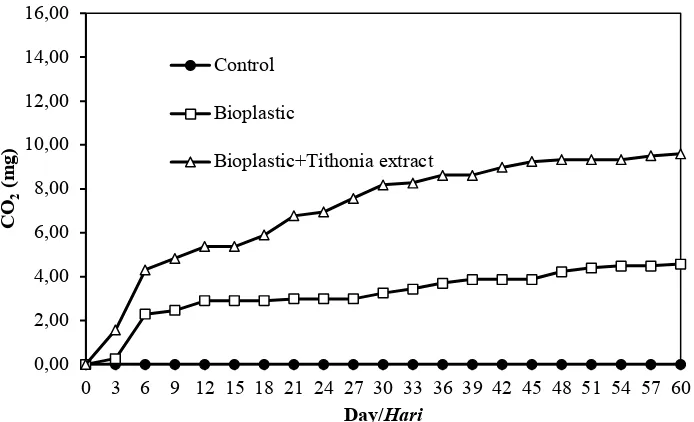56
p-ISSN: 0215-9318/ e-ISSN: 1858-3768 Accreditation Number: 21/E/KPT/2018Effect of
Tithonia diversifolia
extract on the biodegradability of the
bioplastics in plantation soil
Pengaruh ekstrak Tithonia diversifolia terhadap biodegrabilitas bioplastik di tanah perkebunan
ISROI1)*), Nendyo A WIBOWO2), Evi SAVITRI3), Deden D ERIS1) & Agus PURWANTARA1)
1)Indonesian Research Institute for Biotechnology and Bioindustry, Jalan Taman Kencana No 1, Bogor16128, Indonesia 2)Indonesian Industry and Freshner Crops Research Institute, Jl. Raya Parungkuda Km. 2, Sukabumi 43357, Indonesia
3)Indonesian Center for Agricultural Post Harvest Research and Development, Jl. Tentara Pelajar No. 12, Cimanggu,
Bogor 16111, Indonesia
Diterima tgl 14 Februari 2018/ disetujui tgl 26 September 2018
Abstrak
Pengaruh ekstrak Tithonia diversifolia
terhadap biodegradabilitas bioplastik dievaluasi dengan menggunakan tanah perkebunan sebagai inokulum alami. Bioplastik yang digunakan adalah komposit selulosa dari kulit buah kakao, pati dan diperkaya dengan ekstrak tithonia. Uji biodegradasi dilakukan di dalam botol selama 60 hari. Karbon dioksida yang dihasilkan dari uji biodegradasi diserap oleh larutan natrium hidroksida 0,1 N. Karbon dioksida dititrasi dengan HCl 0,1 N dan menggunakan fenolftalein diikuti dengan metil jingga sebagai indikator. Karbon dioksida terdeteksi pada sampel bioplastik namun tidak terdeteksi pada sampel plastik konvensional. Bioplastik yang diperkaya dengan ekstrak tithonia menghasilkan tingkat biodegradasi yang lebih tinggi dari pada bioplastik tanpa ekstrak tithonia. Tingkat biodegradasi sampel bioplastik di tanah perkebunan adalah 0,068 mg CO2/hari dan 0,188
mg CO2/hari masing-masing untuk bioplastik
tanpa dan dengan ekstrak tithonia. Biodegradasi sampel bioplastik selama 45 hari adalah 12,44% dan 28,07% berturut-turut untuk bioplastik tanpa dan dengan ekstrak tithonia. Biodegradasi keseluruhan bioplastik diperkirakan membutuh-kan waktu 244 hari dan 200 hari masing-masing untuk bioplastik tanpa dan dengan ekstrak tithonia.
[Keywords: Tithonia diversifolia, biodegradabi-litas, bioplastik, tanah perkebunan].
Abstract
Effect of Tithonia diversifolia extract on biodegradability of the bioplastic was evaluated using plantation soil as natural inoculum. The bioplastic was a composite of cellulose from cacao pod husk, starch and enriched by tithonia extract. Biodegradation test was conducted in the glass jar for 60 days. The carbon dioxide generated from the biodegradation test titrated by
0.1 N sodium hydroxide solutions. The carbon dioxide was measured with 0.1 N HCl and using phenolphthalein followed by methyl orange as indicator. Carbon dioxide was detected in the bioplastic samples but not detected in the conventional plastic sample during the test. Biodegradation of the bioplastic enriched by tithonia extract was higher than that of the bioplastic without tithonia extract. Biodegra-dation rate of the bioplastic samples in plantation soil were 0.068 mg CO2/day and 0.178 mg
CO2/day for the bioplastic without and with
tithonia extract, respectively. Biodegradation of the bioplastic samples for 45 days were 12.44% and 28.07% for the bioplastic without and with
tithonia extract, respectively. Complete
biodegradation of the bioplastic predicted in 244 days and 200 days for the bioplastic without and with tithonia extract, respectively.
[Kata kunci : Tithonia diversifolia, biodegrada-bility, bioplastic, plantation soil].
Introduction
The production of cocoa beans in Indonesia has decreased since 2010, although the area of cocoa plantation has increased. The lowest production in 2015 was 66,243 tons. Cocoa productivity has declined since 2000. Indonesia’s cocoa productivity in 2000 was 724 kg/ha and decreased by 52% to 383 kg/ha in 2015 (Dirjenbun, 2016). The decline of the cocoa production can be accounted for by a number of factors, i.e.: decreasing soil fertility and organic matter content; and an increased incidence of pests/diseases, such as cocoa pod borer (CPB)
caused by Conopomorpha cramerella and
Phytoptora pod rod (McMahon et al., 2015). The cocoa pod sleeving using plastic or biodegradable
Effect of Tithonia diversifolia extract on the biodegradibility………(Isroi et al.)
plastic (Saripah et al., 2007; Rosmana et al., 2013; Joseph et al., 2017). This method is most effective when compared to other methods. Sleeving of the cocoa pod can suppress CPB attacks up to 85-95%. However, the use of plastic that cannot biodegradable in nature still allows the emergence of plastic waste. Use of the biodegradable plastic could be a potential technique to control CPB and save for the environment (Sembel et al., 2011).
Our research team developed a bioplastic composite made of cellulose and starch and used to control CPB in cocoa plantation. The bioplastic enriched by an extract of Tithonia diversifolia as organic pesticide. The bioplastic was successfully made into sheet and bag. However, although all components in the bioplastic are biodegradable, but biodegradability of the bioplastic has not tested. Aims of this research is to test the biodegradability of the bioplastic in plantation soil as natural inoculum by measurement of carbon dioxide released during biodegradation the test. Degradation of the bioplastic in aerobic condition by microorganism would release carbon dioxide, water and heat as degradation result. The carbon dioxide was measured by titration matrix biopolymer and glycerol as plasticizer. The cellulose fiber was extracted and purified from cocoa pod husk by soda caustic methods (Isroi et al., 2017). Ratio between cellulose and starch was 25:75 by weight. Bioplastic made by casting methods in acrylic plate 20 cm x 20 cm. Other bioplastic sample was a bioplastic enriched by
Tithonia diversifolia extract. The plant extract prepared by pilot scale extractor and using water as solvent. The plant extract added in the bioplastic formulation by 10% from the total volume. All the samples were cut into 1 cm to 1 cm pieces. The all samples keep in desiccator to maintain the humidity before use.
Plantation soil
The inoculum used in the biodegradation test was local plantation soil, Dramaga, Bogor West Java, collected from the top soil 5 cm to 10 cm in deep. The soil was screened to remove debris and an organic material. Characteristics of the soil inoculum was shown in Tabel 1.
Biodegradation test
Biodegradation of biomass material, such as bioplastic, by microorganism in aerobic condition released carbon dioxide, water and heat. Amount of the carbon dioxide proportional to degradation of the bioplastic. Biodegradation test was conducted in 300 ml glass bottle arrangement as Figure 1 according to the reference (Khaswar et al., 2008). A quantity of 100 g of the plantation soil was placed into the samples bottle. Each bioplastic and reference plastics samples (±0.1 g) were placed and buried into the soil. A bottle and reduce the concentration of sodium hydroxide accordingly. All experiment held in duplo experiment and in room temperature (28oC) for 45
days. Every tree days the sodium hydroxide was replaced and analyzed for carbon dioxide.
Figure 1. Experimental setup of the biodegradation
Jumlah total koloni (TPC) (cfu/g)
1
Carbon dioxide analysis
The carbon dioxide entrapped in the sodium hydroxide determined by titration with 0.1 N hydrochloric acid solution. Phenolphthalein (PP) used as first indicator and methyl orange as second indicator. Amount of hydrochloric acid needed to neutralized the solution into pink is proportional with the amount of sodium hydroxide after being reduced by the reaction
with carbon dioxide releases during the
biodegradation test
Results and Discussion
Bioplastic properties
Lignocellulose content of the cellulose fiber extracted from the cocoa pod shown in Table 2. The cellulose content was 50.58%. This cellulose content increasing two times than initial cocoa pod. Hemicellulose content was the highest lingo-cellulose in the cocoa pod (Daud et al., 2013). Cellulose fiber extraction by soda caustic methods reduce the hemicellulose and extractive. The lignin content remains the same percentage as in the initial content. Cellulose content obtained in this research are similar as reported as by Hutomo
et al., (2012). Soda caustic methods are reduced more hemicellulose than others lignocellulose
component. Dominant amount of the
hemicellulose and reactivity of the hemi-cellulose to soda caustic could be cause of this result.
The bioplastic is a cellulose:starch based bioplastic and made by casting method. Glycerol are used as plasticizer. Bioplastic sheets and appearance of the bioplastics shown in Figure 2. Bioplastic without tithonia extract is more transparent and opaque than bioplastic enriched with tithonia extract. Bioplastic with tithonia extract is darker than the previous one. Adding tithonia extract was not affected thickness of the bioplastic. Thickness of these bioplastics are 90-110µm. Two physical properties of the bioplastics
are presented in Figure 3. Adding plant extract increased the WVTR (water vapour transmittance rate) of the bioplastic. Higher WVTR mean that the bioplastic absorbs more water from the environment. Increasing WVTR followed by significantly reducing tensile strength of the bioplastic as shown in the graphic.
Carbon dioxide released during the biodegradation test
Plantation soil rich in microorganism and the total colony was 21.3 x 105 colony per g soil
including bacteria, fungi and actinomycetes. These microorganisms used organic carbon as energy source. In aerobic condition the organic material, such as bioplastics, would be bio-degraded into CO2, H2O and produce heat
(Adhikari et al., 2016). The carbon dioxide released are fluctuate time by time and shown in Figure 4. Carbon dioxide from the control experiment, without bioplastic samples, was carbon dioxide released from the original organic carbon source in the soil. Carbon dioxide released from the bioplastic experiments were sum of the carbon dioxide released from the bioplastic and from the original organic carbon source.
Table 2. Lignocellulose content of the cocoa pod cellulose fibre
Tabel 2. Kandungan lingoselulosa dari serat selulosa kulit buah kakao
Content/Kandungan Persentage/Persentase (%) Hot water soluble
(HWS)/
Komponen Larut Air Panas
3.99
Cellulose/Selulosa 50.58
Hemicellulose/ Hemiselulosa
10.07
Lignin/Lignin 34.60
Ash/Abu 0.76
Figure 2. Bioplastic composite of cellulose from pod cacao and starch: (A) bioplastic without tithonia extract and (B) bioplastic enriched with tithonia extract
Gambar 2. Komposit bioplastic dari selulosa kulit buah kakao dan pati: (A) bioplastik tanpa penambahan ekstrak tithonia dan (B) bioplastik dengan penambahan ekstrak tithonia
2
Effect of Tithonia diversifolia extract on the biodegradibility………(Isroi et al.)Figure 3. Water vapour transmittance rate (WVTR) and tensile strength of the bioplastic samples Gambar 3. Water vapour transmittance rate (WVTR) dan kuat tarik dari contoh bioplastik
Figure 4. Carbon dioxide (mg) released during the biodegradation test Gambar 4. Karbon dioksida (mgr) yang dilepaskan selama uji biodegradasi
During the first six days, the microorganisms were very active to degrade the organic carbon as shown by high CO2 released. Evolution of the
CO2 then gradually reduce and become more
stable two weeks after incubation. Evolution of the CO2 on the control experiment was the lowest.
The CO2 evolution from the bioplastic enriched
with tithonia extract was higher than from the bioplastic without tithonia extract. Although tithonia extract are known as organic pesticide for some insect larvae (Otusanya & Ilori, 2012), but this plant extract not toxic for the microorganisms and could be degraded by microorganism. Content of the tithonia extract are flavonoid and terpenoid (Miranda et al., 2015). The percentage content of the tithonia extract used in this study was 3.46% flavonoid and 0.05% tannin.
Biodegradation rate
Biodegradation of the bioplastic samples were represented as sum of the carbon dioxide released from the bioplastic samples and subtracted by control experiment. Biodegradation of the bioplastic samples are shown in Figure 5. In
accordance with the previous graphic,
biodegradation of the bioplastic enriched with tithonia extract was higher than the bioplastic without plant extract. The bioplastic without plant extract initiated to biodegraded at the day three, then the biodegradation rate slower and become stable after three weeks. The bioplastic with plant extract already biodegraded from the beginning and continued until the end of the study. Total CO2 released during the biodegradation test was
4.58 mg and 9.59 mg for the bioplastic without plant extract and enriched with plant extract, respectively.
Biodegradation rate of the bioplastic samples predicted by regression analysis of the data. Biodegradation rate of the bioplastic samples were 0.059 mg CO2/day and 0.131 mg CO2/day
for the bioplastic without plant extract and enriched with plant extract, respectively. Its mean that the based bioplastic enriched with the plant
extract are easier to biodegraded by
microorganism than the bioplastic without the plant extract. By calculation, total degradation of the bioplastic samples were 428 days and 215 days, respectively. Resume of the biodegradation test presented in Table 3.
0,0 1,0 2,0 3,0 4,0
0 3 6 9 12 15 18 21 24 27 30 33 36 39 42 45 48 51 54 57 60
CO
2
(m
g
)
Day/Hari
Control Bioplastic
1
Figure 5. Total carbon dioxide (mg/day) released during the biodegradation test from the bioplastic samples correctedwith the control experiment
Gambar 5. Karbon dioksida total (mgr/hari) yang dilepaskan selama uji biodegradasi untuk contoh bioplastik yang sudah dikoreksi dengan perlakuan kontrol
Table 3. Resume of the biodegradation test of the bioplastic samples Tabel 3. Ringkasan hasil pengujian biodegradasi contoh bioplastik
Samples/Contoh Theoretical CO2/
CO2 Teoritis
(mg)
Biodegradation rate/ Kecepatan biodegradasi
(mg CO2/day)
Prediction of the total biodegradation/ Perkiraan waktu biodegradasi total (day)
Bioplastic/Bioplastik 26.626 0.059 428
Bioplastic+tithonia extract/ Bioplastik+ekstrakt tithonia
31.370 0.131 215
Conclusion
Advantages of the bioplastic compared to the conventional plastic for controlling CPB are biodegradability in natural environment. This study is successfully shown the biodegradation of the bioplastic samples in plantation soil. All bioplastic samples could be biodegraded by microorganism as shown by CO2 evolution during
the test. Adding tithonia extract to the bioplastic
formulation has benefit effect to the
biodegradability of the bioplastic. In other hand, the plant extract could act as organic pesticide for the larvae of the CPB.
Acknowledgements
This research is funded by Indonesian Agency for Research and Development, Ministry of Agriculture, by KP4S Program 2017.
References
Adhikari D, Mukai M, Kubota K, Kai T, Kaneko N, Araki KS & Kubo M (2016). Degradation of bioplastics in soil and their degradation effects on environmental microorganisms. Journal of Agricultural Chemistry and Environment, 5(1), 23.
Afrizon & Rosmana S (2002). Efektivitas komponen pengendalian hama penggerek
buah kakao (PBK) terhadap tingkat
serangan PBK di Kabupaten Kepahiang.
Jurnal Litbang Pertanian21(2), 69–74. Daud Z, Kassim M, Sari A, Mohd Aripin A,
Awang H, Hatta M & Zainuri M (2013). Chemical composition and morphological of cocoa pod husks and cassava peels for pulp and paper production. Australian Journal of Basic and Applied Sciences7(9), 406–411.
Depparaba F (2002). Penggerek buah kakao (Conopomorpha cramerella Snellen) dan
penanggulangannya. Jurnal Litbang
Pertanian, 21(2), 69–74.
Dirjenbun (2016). Statistik Perkebunan
Indonesia: Kakao 2014-2016. Jakarta. Hutomo GS, Marseno DW, Anggrahini S &
Supriyanto. (2012). Synthesis and
characterization of sodium
carboxymethylcellulose from pod husk of Cacao (Theobroma cacao L.). African Journal of Food Science6(6), 180–185. 0,00
2,00 4,00 6,00 8,00 10,00 12,00 14,00 16,00
0 3 6 9 12 15 18 21 24 27 30 33 36 39 42 45 48 51 54 57 60
CO
2
(m
g
)
Day/Hari
Control
Bioplastic
2
Isroi, Cifriadi A, Panji T, Wibowo NA & Syamsu K (2017). Bioplastic production from cellulose of oil palm empty fruit bunch. IOP Conference Series: Earth and Environmental Science, 65, 12011.
https://doi.org/10.1088/1755-1315/65/1/012011
Joseph KC, Montepio RC, Abenoja RM & Tuyogon RF (2017). Design, development and evaluation of a mechanical cacao pod bagger/sleever. International Journal of Scientific & Engineering Research 8(5), 585–589.
Khaswar S, Setyowati K & Khoiri AA (2008). The effect of plastisizer additions (polyethylene glycol 400 and dimethyl phtalate) on the biodegradation process of bioplastics poly-b-hydroxyalkanoat in liquid media with limited air. Jurnal Teknologi Pertanian4(1), 4–14.
McMahon P, bin Purung H, Lambert S, Mulia S, Susilo AW, Sulistyowati E, Sukamto S, Israel M, Saftar A, Amir A, Purwantara A, Iswanto A, Guest D & Keane P (2015). Testing local cocoa selections in three provinces in Sulawesi:(i) Productivity and resistance to cocoa pod borer and Phytophthora pod rot (black pod). Crop Protection70, 28–39.
Miranda MAFM, Varela RM, Torres A, Molinillo
JMG, Gualtieri SCJ & Mac’ias FA (2015). Phytotoxins from Tithonia diversifolia.
Journal of Natural Products 78(5), 1083– 1092.
Otusanya O & Ilori O (2012). Phytochemical screening and the phytotoxic effects of aqueous extracts of Tithonia diversifolia
(Hemsl) a. Gray. International Journal of Biology4(3), 97.
Rosmana A, Shepard M, Hebbar P & Mustari A (2013). Control of cocoa pod borer and phytophthora pod rot using degradable plastic pod sleeves and a nematode,
Steinernema carpocapsae. Indonesian Journal of Agricultural Science 11(2), 41– 47.
Saripah B, Azhar I, Board MC & Floor WS (2007). Implementation of cocoa pod sleeving in controlling cocoa pod borer infestation. In 2007 Conference on Plantation Commodities, Putra World Trade Centre, Kuala Lumpur (Malaysia), 3-4 Jul 2007.
Sembel DT, Watung J, Shepard M, Hamming M & Carner GR (2011). Control of cacao pod borer, Conopomorpha cramerella Snellen on cacao plantations in North Sulawesi
using degradable polymer sleeves.
EUGENIA, 17(2)102-107.



